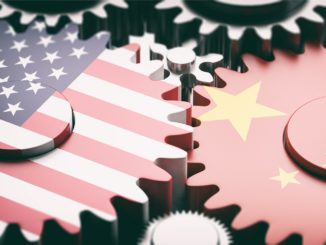
The 13th Five Year Plan and other programs to bolster cloud adoption among Chinese businesses like the Internet Plus effort have lit a fire under China’s tech and industrial sectors to modernize IT operations.
However, the growth of China’s cloud and overall enterprise IT market is far slower than in other nations. while there is a robust hardware business in the country, the traditional view of enterprise-class software is still sinking in, leaving a gap between hardware and software spending. Further, the areas that truly drive tech spending, including CPUs and enterprise software and services, are the key areas where the money is—and the main segments where China lags behind, despite more recent efforts to push a homegrown chip agenda for everything from supercomputers, standard servers, and consumer devices.
The programs mentioned above have been successful from a funding, policy, and practice standpoint, but in the process of filtering out foreign influence in the market to create a richer Chinese IT environment, there is a constraining effect. Many of the new technologies being developed are serving the local market, but are not moving outside of China to capture larger growth potential.
In a recent statement for the U.S. and China Economic and Security Review Commission, Mark Brinda, partner at Bain & Company research firm examined the subtle differences between how the two nations spend on IT infrastructure, with an emphasis on cloud computing infrastructure, software, and services. Recommendations were provided for the U.S. to monitor the relative strength of the white box server market given China’s manufacturing prowess, while continuing to invest in software, services, and processors as those represent U.S. strength—and over 70% of the current IT infrastructure spending.
Compared to other large world economies, China’s overall spending on IT is far less when matched against GDP. Two years ago, the U.S. market for IT was equal to 2.8% of GDP and the UK’s IT sector fed 3.0%. China’s market, however, added only 0.5%. Although it might seem this is a consequence of emerging markets, Brinda points to Brazil as an example, noting IT GDP contribution of 1.2%.
There are a number of factors that contribute to this relative lack of enterprise IT spending in China, despite government investments in the tech and industrial sectors to push cloud, HPC, and enterprise computing. Brinda says the “market for software and services are disproportionately small relative to the market for hardware” and that “software piracy has long been a common practice for Chinese enterprises and the use of third parties to outsource the build, operation, and maintenance of IT is still not a standard practice, especially with state owned enterprises.” In short, China spends big on hardware and far less on software and services, reflecting a similar trend in Russia in particular.
The emphasis on state owned enterprise is important here. It is estimated that roughly 75% of total IT spend is driven by these business in China, “a share so large that the posture of this segment toward the cloud will effectively determine the course and speed of cloud evolution in China,” Brinda says. As anyone who watches large government organizations or institutions adapt their IT environments to change, it is not hard to see why China might be a little slower in adopting cloud, especially with state owned entities driving the demand. Besides, many of the state-owned enterprises in China have the security woes so remarked upon in the early days of public cloud in the U.S.—these are the biggest energy, telco, and government agencies in China, laden as they are with mature IT environments that are thrown into disarray with new software stacks or operating environments.
“A look at the market share of local versus international players reveals that international players make up a significant majority of the market in China. Despite local participants in almost every category, Chinese companies, including state owned enterprises, have widely used U.S. technology, Brinda says. “While there are factors at play in the market for cloud that will drive higher share for Chinese firms in some market segments, international players will continue to play a major role in the Chinese IT market, particularly in categories like CPUs, infrastructure software and IT outsourcing where no commercially viable, large-scale, local alternatives exist.”
The Alibaba-owned major cloud company in China, Aliyun, is considered the AWS of China, and while both Microsoft and AWS have cloud offerings in China, Aliyun is the top IaaS provider. As Brinda explains, “in terms of technology features and functionality, Aliyun is still not at full parity with AWS and Azure, but is close on most core services like compute, storage, and database.” He says they have succeeded by capturing that all important state-owned business market as well as Chinese startups.
“Aliyun has achieved near-parity on some competitive dimensions and has actually differentiated on other dimensions that resonate with the Chinese market. While Aliyun has yet to make any significant headway internationally, the business certainly has ambitions to play in both the U.S. and other markets where Chinese technology firms have been successful. Jack Ma has reportedly met with President Trump and the company has considered U.S.-based M&A. The U.S. market will be a challenge. There are no obvious scale acquisition targets and the likelihood is low that a new entrant from China will organically achieve scale in a mature market where the #1 barrier to purchase is data privacy and security.”
The SaaS market in China is a bit trickier to pin down because the notion of paying for software is still somewhat foreign to some Chinese companies. Brinda expects SaaS adoption to grow inside China but says those offerings will likely not emerge out of the country.
On the hardware front, which is where China’s enterprise IT investments are most clear, Chinese companies including Quanta, Inspur, Wistron and others have been successful for on-site and cloud-building customers. Brinda says this market “directly leverages China’s core strength in manufacturing, supply chain and logistics since this is more of a manufacturing business than technology business.” He points to the fact that there is little IP included in what those hardware makers ship. “While this is not a particularly attractive business, it is a vital one, not just to cloud but to the entire IT infrastructure market. There are no scale alternatives outside of China and Taiwan. Should a trade war break out or some other global disruption occur that severs the link between U.S. cloud providers and these supplies there would be a significant and sustained disruption in the global IT market.”
“The segment of this market where the U.S. is not only less competitive but non-competitive is that of manufacturing custom designed hardware at scale. This is a market where the Chinese and Taiwanese lead globally and U.S. firms have not attempted to compete. Profit margins in this business are razor thin and global supply chains for many of the heaviest components (e.g. server chassis, motherboards, SSDs) originate in Asia, advantaging Chinese firms relative to a potential U.S. entrant,” Brinda argues.
Brinda and his research team at Bain expect the Chinese IT market to contribute 2.5-4% of the total global cloud market by 2020 and grow to a total of $13-$19 billion by 2020. More details, including the full recommendations to the committee can be found here.





Be the first to comment